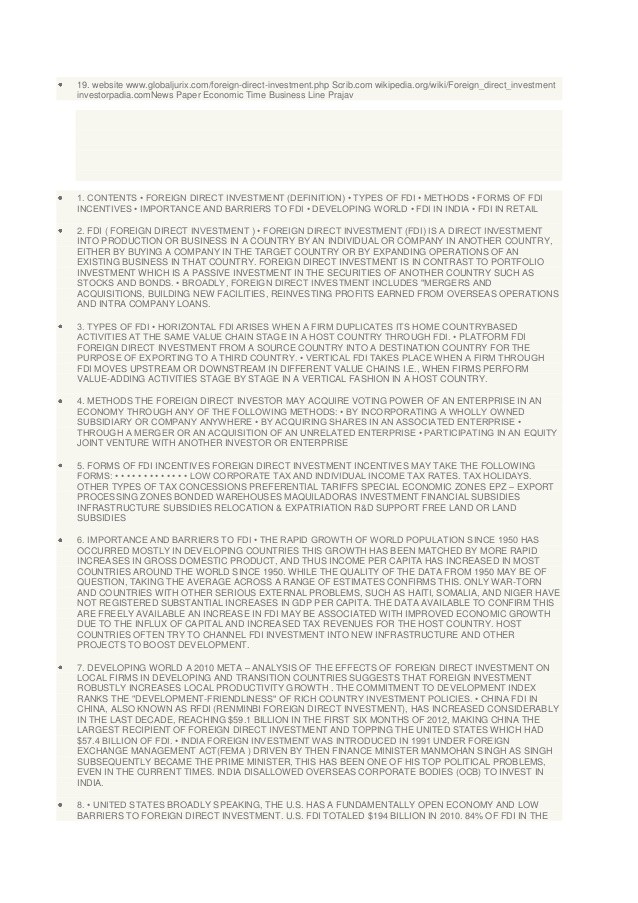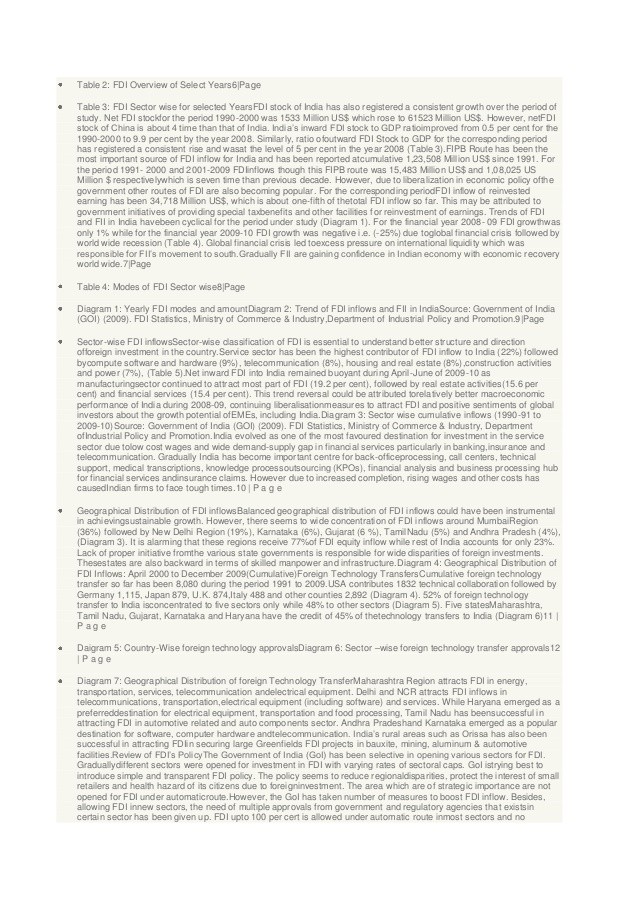FDI and FPI Strategic Complements
Post on: 17 Май, 2015 No Comment

This paper can be downloaded from
FDI and FPI — Strategic Complements?
Barbara Pfe¤er
Universität Siegen, Department of Economics
Hölderlinstraße 3
Abstract
We show in a dynamic investment setting whether …rms choose FDI
or international portfolio investment (FPI) in the presence of stochastic
productivity taking into account di¤erences in ‡exibility of both invest-
ments. Isolated FPI and FDI investments are compared to combined FPI
and FDI investments. FDI requires higher investment speci…c costs than
FPI. Thus, it is not possible to adjust FDI to environmental changes every
period. In contrast, FPI bears lower …xed costs and can be adjusted im-
mediately to short-term changes in the environment. Additionally, as a
result of the investors’ control position FDI yields a higher return than
FPI. Hence, there is a trade-o¤ between ‡exibility and higher return for
…rms deciding between FDI and FPI. We explore whether as a consequence
of higher investment speci…c …xed costs and lower ‡exibility in the case
1Introduction
The recent World Investment Report 2006 highlights that Foreign Direct In-
vestment (FDI) ‡ows and growing FDI stocks are now at an unparalleled level
with most going to industrial countries. At the same time ‡ows of international
portfolio investments (FPI) exceeded FDI ‡ows twice at the beginning of the
nineties while more recently FPI growth slowed down and both capital ‡ows
converged (WTO 1996). What are the motives for …rms to invest in one or the
other and how are they to be explained?
Previous studies on FDI explained the motives for FDI with di¤erential rates
of return, di¤erences in interest rates and risk diversi…cation (Dunning (1973)).
Following Andersen and Hainaut (1998) these determinants lost explanatory
power and recent theoretical and empirical studies document that FDI is un-
dertaken to exploit cost advantages (vertical FDI) or to serve di¤erent markets
locally to avoid trade costs (horizontal FDI).2,3If FDI no longer serves risk
diversi…cation does FPI …ll the gap and are these capital ‡ows strategic com-
plements rather than substitutes?4
We analyse whether …rms choose FDI or FPI in the presence of stochastic
productivity taking into account di¤erences in ‡exibility of both investments.
As FDI requires higher investment speci…c costs it is not possible to adjust FDI
to environmental changes every period.5In contrast, FPI bears lower …xed costs
and can be adjusted immediately to short-term changes in the environment. In
particular the assumption is that FDI is less ‡exible than FPI and this reduced
‡exibility entails a higher rigidity of FDI. A further distinction between FDI
and FPI is the possibility to exert control.
the investor. Thus, the investor is manager and owner in one person. He has
easy access to all information and has the possibility to navigate the investment
according to his own interests. FPI on the other hand does not comprise control
rights. In this case, the investor and the manager are di¤erent persons with
FDI encloses control rights for
1University of Siegen, Department of Ecoonomics, Hölderlinstraße 3, 57068 Siegen, Tel:
+49 271 740 4044, pfe¤er@vwl.wiwi.uni-siegen.de
2Grossman, Helpman, Szeidl (2005) discuss in which states …rms decide to outsource or
o¤shore some of their production stages. Acemoglu, Aghion, Gri¢th and Zilibotti show that
vertical integration is more common if the technology intensity di¤ers signi…cantly.
3See Helpman, Melitz, Yeaple (2003) for a detailed survey whether …rms decide to serve
a foreign market through export or FDI — horizontal FDI. Studies of complex FDI strategies
can be found for example in Helpman (2006) or Grossman, Helpmann, Szeidl (2003).
4In contrast to the consumer theory, the cross-price elasticity of demand is not the decisive
factor for the present distinction between complements and substitutes. In the present analy-
sis strategic-complements represents the conscious choice of the investor to combine both
investment instruments. The decision whether to combine both investments depends not only
on the price / costs of the investment but the risk correlation and ‡exibility of the respective
investment instrument.
5See Goldstein and Razin (2005) for a discussion of the di¤erent costs for FDI and FPI.
Page 4
di¤ering interests. Information asymmetries and agency problems can arise.
Consequently, the investment project is not necessarily completely managed in
line with investors’ interest. Following Goldstein and Razin (2004), as a result of
the investors’ control position FDI yields a higher return than FPI. Hence, there
is a trade-o¤ between ‡exibility and higher return for …rms deciding between
FDI and FPI. We explore whether as a consequence of higher investment speci…c
…xed costs and lower ‡exibility in the case of FDI, small …rms prefer FPI and
larger …rms invest in FDI.
We show that the combined investment strategy (FDI and FPI at the same
time) always starts the international investment activity earlier in time than
the isolated strategy (FDI or FPI). Additionally, with combined international
investment, there is a higher incentive for …rms to invest in research and devel-
opment (R&D) and consequently …rm productivity increases faster than with
isolated international investment. Depending on the success-probability and the
correlation between the various investment possibilities, even small …rms (low
productivity) invest in FDI.
To model …rm behaviour we use a monopolistic competition framework with
uncertain …rm productivity in combination with a dynamic investment approach
over a …nite investment horizon. There are three countries, home and two
foreign countries. The …rms are located in the home country and decide to
invest via FDI or FPI in the foreign countries. Thereby, they face uncertainty
about their future productivity and returns on the respective investment. In

particular, …rm productivity is endogenous and follows a Poisson process. The
productivity of the di¤erent investment opportunities are correlated with each
other. Di¤erences in correlation between FDI and home production account for
di¤erent forms of FDI.6
The reminder of this paper is organized as follows. In section 2, we examine
the di¤erent de…nitions of FDI and FPI and explain the motivations for …rms to
Page 5
2Why should …rms diversify their risk and why
should they combine FDI and FPI?
The …rst problem that arises is to distinguish between the two investment in-
struments FDI and FPI. FDI and FPI consist of di¤erent kinds of foreign equity
interests like equity shares, securities or derivatives.7Most of all, the explana-
tion of FDI and the accompanying activities are not unambiguous. There is the
macro view which counts FDI as a speci…c capital ‡ow between various coun-
tries. It measures FDI in Balance of Payments Statistics. On the other hand,
the micro view examines the motivations of foreign direct investment from the
investors’ point of view. This view concentrates especially on the consequences
resulting from investment for the investor, the host and the home country as
well as on the …rm activities. The main emphasize is that the motivation as
well as the consequences of FDI arise from the investors’ — the investing …rms’ -
control and in‡uence on the management of the foreign investment or a¢liate.
However, the de…nition of FDI does not only change with the underlying theory
but also has changed in time and still changes with institution. A prominent
and widely accepted de…nition is the IMF (1993) concept. It is stated rela-
tively vague that a direct investment is international investment that comprises
a long-term interest in the relationship between the investing and the foreign
…rm. Furthermore, the investing …rm clearly possesses a signi…cant in‡uence on
the management or production process of the foreign …rm. In addition to this
rather loose concept, the IMF exempli…es a speci…c recommendation of 10%
share-ownership at which FDI and a corresponding degree of control is identi-
…ed. The IMF FDI perception complies with the Balance of Payment Statistics
view of FDI. The micro view is more represented by the FDI de…nition of the
United Nations System of National Accounts. In this concept, the main em-
phasis is placed on the investors’ control on the foreign …rm. The threshold for
control and a perceptible in‡uence on the foreign …rm is at 10 — 50% or more of
shares owned by the investing …rm. The precise share depends on the individual
country de…nition of foreign control.8These are only two examples for the dif-
fering concepts and de…nitions of FDI. Based on these diverging perceptions it is
di¢cult to distinguish explicitly between FDI and FPI. Moreover, the ambigu-
ous de…nitions do not really provide a clear cut between FDI and FPI: Lipsey
(1988) quotes an example where previous portfolios ‡ows were converted into
direct investment ‡ows. Hence, there is no unambiguous distinction of FDI and
FPI from the composition of the respective capital ‡ow or by a de…nite control














